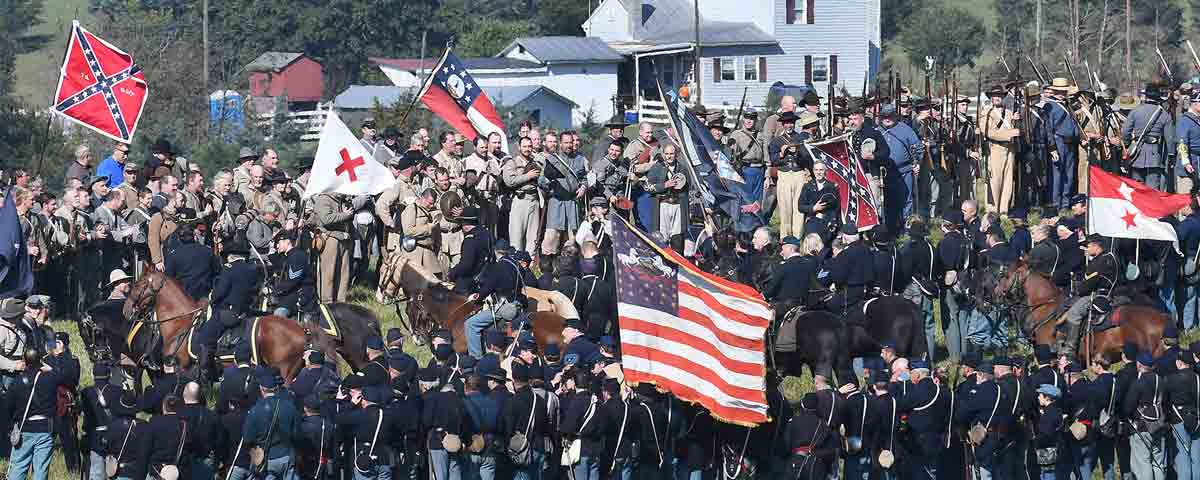Devoted Civil War reenactors feeling politically charged public discord, threat of violence
[dropcap]T[/dropcap]wenty years ago, in the swashbuckling heyday of Civil War reenacting, the unpleasant spectacle that unfolded in the fall in the rolling meadows of the Shenandoah Valley would have been unthinkable. Back then it was all hale and hearty huzzahs, as tens of thousands of relatively young men swarmed the fields outside Gettysburg, Antietam, and Shiloh and spellbound audiences got a real taste of the awesome size, sounds, and smoke of the terrible war that nearly toppled a nation. What was missing from these productions was the hate.
[quote style=”boxed” float=”right”]Reenactors passionately affirm that they exist to honor history, not to serve as a conduit for hatred.[/quote]
This past October, in Middletown, Va., the hate was very much there, as reports of a suspected pipe bomb forced police to lock down the reenactment of the 1864 Battle of Cedar Creek. Days earlier, the Cedar Creek Battlefield Foundation had posted a message on its website warning participants that it had received threats of violence, but few dreamed it was anything more than an idle threat.
In the aftermath of Cedar Creek, reenactors said they would not be intimidated and lamented unschooled individuals who believe reenactments are in some way analogous to tiki-torch rallies staged by white nationalists. The show would go on, they said, and reenacting would not die out due to a misunderstanding.
Except there is more to it than that. While passing the flask around the campfire, poking fun at so-called “farbs” (i.e., Far Be it from Authentic reenactors) discussing the relative wisdom of Union Maj. Gen. Dan Sickles’ salient at Gettysburg, the conversation among serious-minded Civil War reenactors is increasingly taking a darker turn. As everything from pop culture to current events seems to be conspiring against their beloved hobby, they wonder what reenacting will look like a generation from now, or whether it will even exist in anything like its current form.
Young people aren’t as interested. Reenactors themselves are jumping ship, either retiring, scaling back, or moving on to portray battles in World Wars I and II. And now they are drawing unwanted attention from a segment of the public that assumes anything having to do with the Civil War is closeted racism.
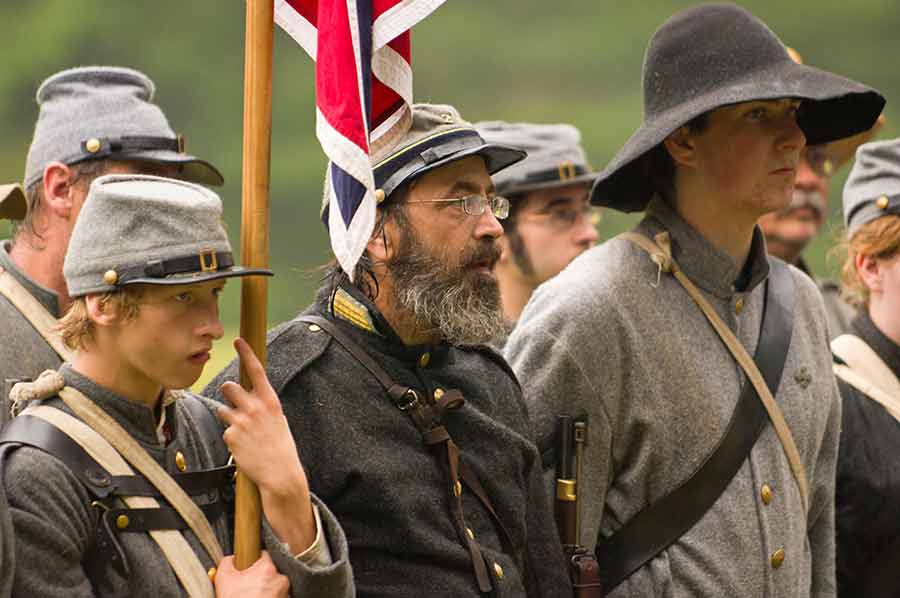
Reenactors passionately affirm that they exist to honor history, not to serve as a conduit for hatred. But the history of the Civil War is entwined with hatred, both racial and political, and reenactors are confronted with emerging evidence that, in the public’s eyes at least, it is not always easy to take a scalpel and cleanly separate one from the other.
Civil War reenacting has survived many ups and downs. But today, reenactors are openly wondering if they might be facing a perfect storm of obstacles that will transform legions of blue and gray engaged in explosive dramas into a few lone soldiers leaning on their rifles and chewing the fat with a couple of stray tourists from Peoria.
[quote style=”boxed” float=”right”]Civil War reenacting isn’t what it was. The spirited generation that fueled so many great reenactments over the past two decades is losing steam.[/quote]
There are almost as many opinions as there are reenactors—some see the current atmosphere as an opportunity and, much like John Belushi in the 1978 movie Animal House, are trying to rally their fraternity out of its malaise. Perhaps, they say, the adversity will distill the hobby into a purer form of historical authenticity and scholarship.
But all agree that Civil War reenacting isn’t what it was. The spirited generation that fueled so many great reenactments over the past two decades is, as its champions enter their 50s, 60s and 70s, losing steam. Some have aging parents to care for. Some, as they look toward retirement, are more concerned with putting their financial houses in order. Some are just flat exhausted from years of sweltering inside hot wool and sleeping on the hard ground. And everyone’s getting older.
It is not surprising that in the current political and social culture that celebrates sound bites over substance, they are feeling, like Sickles, attacked from all sides and even from within. They have had to fight off the aforementioned farbs who arrive in their motor homes with cases of Bud Light in the fridge. They have worked hard to make it known that they are reenactors, yes, but more than that they are serious historians who fiercely believe that meticulous research is essential to their craft.
But even in the face of all this, reenactors for the most part remain philosophical. They know they have fought the good fight, and opened the eyes of thousands of people to the wonders of history. Their mission is affirmed after each reenactment, as wide-eyed kids and excited adults congratulate their performance and ask a litany of questions. Living history in one form or another will survive.
They also know that the Lord works in mysterious ways, and that out of the blue a movie, a TV show, or even a current event can be good for business. Andy Fulks, owner of Fall Creek Suttlery in Lebanon, Ind., said he had never done much business in Confederate flags—until governments began removing them from public property, and the orders came flooding in. So he remains optimistic. “The Civil War probably never is going to be what it was in the ’90s,” he said. “But it won’t die. It will still be there.”
Civil War reenactments have always ebbed and flowed, but something feels different this time. More final, like the end of an era rather than a valley between peaks. A number say they are fed up with the politics, both in and outside the hobby. They despair that of late their hobby has become collateral damage in the culture wars, and they fear that reenacting will unfairly be seen through the same lens as Confederate flags or monuments. It has also angered them.
[quote style=”boxed” float=”left”]They fear that reenacting will unfairly be seen through the same lens as Confederate flags or monuments.[/quote]
“The death threats at Cedar Creek really got people’s dander up,” said Anita Henderson, a physician with rich historical roots—the white side of her family was one of the First Families of Virginia, the black side escaped slavery and went on to help settle the Wild West—whose research led her to portray a Civil War bugler. “They want to dishonor anything that has to do with American history. Normally you just laugh these people off, but they’re arming up.”
And while some used the intended violence as a rallying cry, others lamented the fundamental misunderstanding of reliving the Civil War: that it is about heritage and camaraderie and historical research, not about celebrating the worldviews of Southern planters.
[dropcap]S[/dropcap]till, reenacting had never been entirely free of politics. The centennial firing on Fort Sumter was marred when a black Civil War Centennial Commission delegate from New Jersey was refused the same hotel and dining room accommodations as white delegates. As the Civil Rights movement was gaining traction, there were those who were not above using the garb of a Confederate soldier to strike out at the idea of racial equality.
The first major modern-day reenactment occurred at Bull Run (Manassas) in late July 1961. It was, one reenactor later recalled, “a real hoot,” and it put the fear of the Lord into the National Park Service, which was not in the market for real hoots at its sacred battlefields. The reenactment attracted 100,000 partisan people who cheered and booed, drank and ate, as if they were at a college football game. A half-century later, the fundamental rifts between those cheering factions had not healed, and last August a Manassas reenactment was canceled altogether for fear of violence.
Antietam scholar Tom Clemens said that while today’s reenactors are driven by a love of history, it wasn’t always so. In the old days, he would come across Southern camps devoted to heritage and honoring their forefathers, but others that came across as “traveling cells of the KKK.” Today, that pendulum has swung in the other direction. “It’s the relatively shallow understanding of history that judges 19th century people using 21st century morals,” Clemens said.
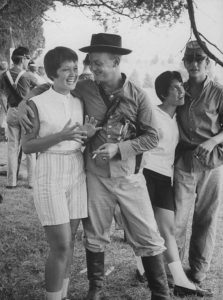
Yet reenacting has been affected by other social, demographic, and political trends as well, sometimes to its benefit, but other times not.
From a pure numbers standpoint, the Baby Boom generation that came of age in the 1960s meant that there were simply more young people available to become involved in reenacting than there are today. Meanwhile, the Vietnam War was making the military socially unpopular, a fact that oddly enough boosted the ranks of the reenactors. Those attracted to the martial life who nevertheless did not want to be tarred with political anger swirling around Vietnam found a home in reenactment camps.
Clemens said there has remained something of an inverse relationship between the military and reenacting: During times of peace, those who are enticed by weaponry, strategy and tactics can join the real Army and get their fill; during times of actual war, it’s safer to be a reenactor.
Frank Ruiz Sr., 62, a colonel with 14th Brooklyn, Company E, remembers the early years when anyone off the street could participate in a reenactment. “They’d tell you to go down to the church basement and they’ll give you a uniform and a gun—it was crazy,” he said. Ruiz had an uncle who would talk of the Civil War, the human element more than the battles, and it ignited a lifelong passion.
“My dad used to make fun of me, because I was 12 years old and I was reading college history books,” he said. Ruiz became formally involved in reenacting in 1996 when he saw an ad on a New York cable station seeking recruits for the Brooklyn regiment. Since then he’s weathered the ups and downs of the hobby and watched as battles on the field devolved into battles on social media.
[dropcap]I[/dropcap]t is difficult to gauge the net effect the computer age has had on reenacting. Certainly it has helped reenactors connect with each other and it has been a boon to scholarship. Today, however, as social media has given a megaphone to previously isolated voices, it appears to be doing the hobby more harm than good.
“I want to stay out of politics, but I read the posts on Facebook and I try not to let my blood pressure get too high,” Ruiz said. “And there’s no way of even knowing if what you read there is accurate.”
And he laments the politics within the reenacting community itself. As with any institution under stress, splintering from within is almost inevitable, and reenacting is no exception. Blame is assigned for the current doldrums: Certain factions are so hard core that of course no one wants to sign up; other factions are so lackadaisical that their historical fraud is evident to even casual bystanders; venues that used to pay reenactors a stipend now charge them a fee; there’s too much bowing to political correctness; and inevitably, complaints that there’s too much complaining.
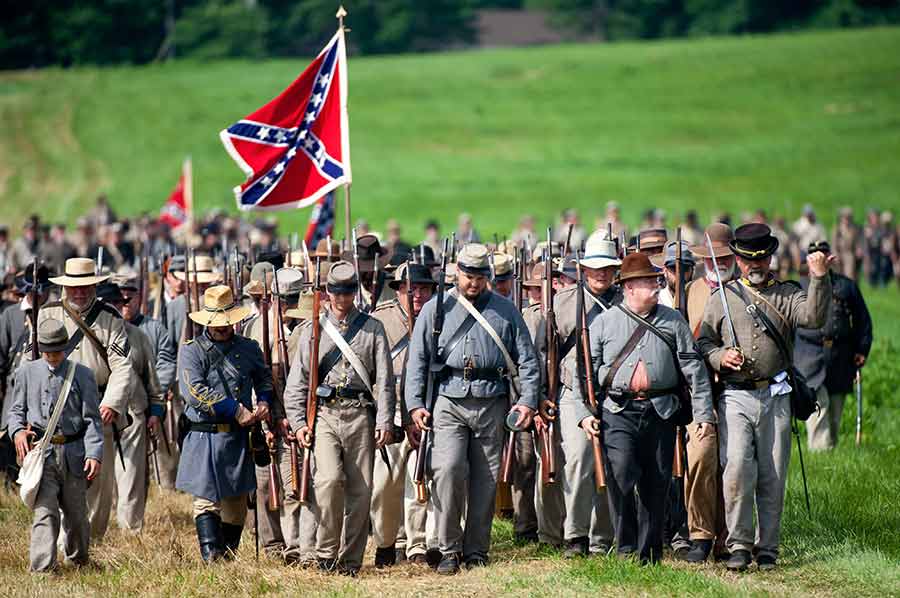
Reenacting reached a crescendo during the decade between the late 1980s and 1990s, for a number of identifiable reasons. The 125th anniversary of the war touched off a series of successful reenactments and provided a muse for filmmakers. Ken Burns’ esteemed series on the Civil War debuted in 1990, a year after the 1989 movie Glory premiered, featuring a star-laden cast that included Denzel Washington, Morgan Freeman, and Matthew Broderick. Three years later the 1993 movie Gettysburg did the unthinkable by making a household name out of a taciturn educator from Maine, Joshua L. Chamberlain.
The late ’80s also saw the inception of a movement toward preserving Civil War battlefields, particularly around Eastern metropolitan areas where urban sprawl was threatening to swallow them whole. In 1987 historians formed the Association for the Preservation of Civil War Sites, the forerunner of the Civil War Trust, touching off a 20-year blitzkrieg that saved storied Civil War battlefields from destruction.
Reenacting played a key role, as the public got to see a facsimile of the fights that made these sites noteworthy. Today, while the Trust is still fighting off battlefield encroachment, such as a Walmart at the Wilderness and a casino at Gettysburg, many of the big battles have been fought, and the fervent mission that fueled reenactors has faded in comparison to what it was at the dawn of the 1990s.
[dropcap]T[/dropcap]he success of reenacting, which demands a relatively sizable outlay for uniforms, weapons and travel costs, not to mention the significant investment in time, is also strongly tied to the economy. The solid economy of the 1990s was good not only for reenactors, but also for the people who liked to watch, many of whom planned vacations around Civil War reenactments. And for a time, it seemed the reenactments themselves would keep getting bigger. In 1997 the 135th reenactments of Antietam drew 15,000 reenactors, and a year later Gettysburg drew more than 20,000, with at least 50,000 spectators.
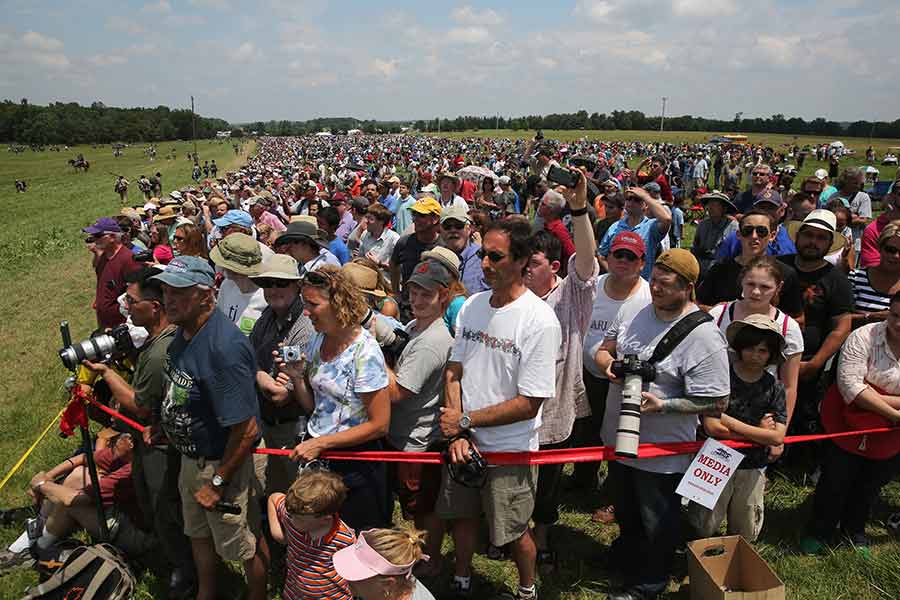
By 2000 the number of reenactors nationwide seemed to be holding steady at about 50,000. Then the bottom dropped out as the number of reenactors over the next 17 years fell by as much as half. Certainly some of the blame goes to the housing crisis and ensuing financial meltdown of 2007. For reenacting, on the eve of what should have been the hobby’s ultimate commemoration, the timing could scarcely have been worse.
Many reenactors today see the 150th commemoration as an unfortunate tipping point. Reenacting got a bit of a bounce, but the magic of the 1990s was never recaptured. The economy remained sluggish, Hollywood had moved on and men who 25 years prior had been full of youthful energy were now applying for Social Security.
[quote style=”boxed” float=”left”]For whatever reason, kids aren’t as enthralled with reenacting as they once were, nor does the camaraderie seem to matter to them.[/quote]
Chip Smith, 54, of Mechanicsburg, Pa., has been reenacting since the mid-1970s, and “I’m considered one of the, quote, younger guys,” he said, adding that every year seems to bring another funeral of a reenacting comrade.
And for whatever reason, kids aren’t as enthralled with reenacting as they once were, nor does the camaraderie seem to matter to them. “They get all the socialization they need on their phones,” Clemens said. “It’s an interesting phenomenon.”
Smith, like other reenactors, says recruiting efforts that used to bring in a dependable stream of new blood are now providing few rewards. “It seems like every time we do something nothing comes of it,” he said. “We used to give talks to the Boy Scouts, but we don’t get invited anymore because they don’t want guns in the churches. It’s a changing world.”
And like others, he has watched as thousands of participants in reenactments dwindle away into the hundreds, “The days of the big battles are probably gone, Smith said. “We talk about it a lot, wondering what happened. In the end, life has a way of creeping up on you.”
Many reenactors were determined to make one last push through the sesquicentennial, and then call it a career. Then just as the 150th commemorations were winding down, along came controversies over racial justice, the Confederate battle flag, and monuments erected to Southern leaders. A spate of reenactments were canceled due to fears of protests, controversy, and violence. In New York, Ruiz said he was participating in a reenactment for the benefit of a horse rescue, when the curator of the site pulled him aside and asked if the Confederates would be bringing Confederate flags. “They wanted the Confederates to come without their flags,” he said. The event didn’t happen.
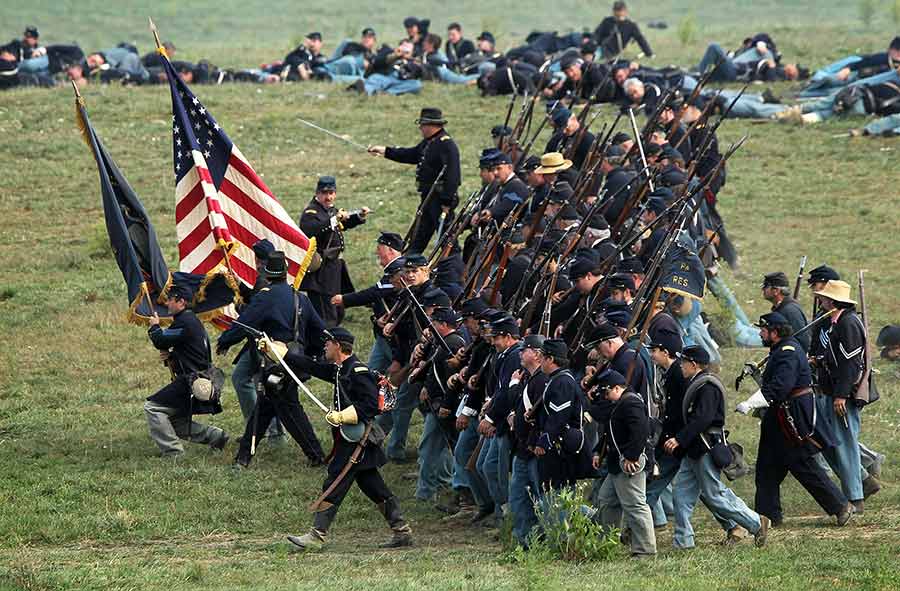
“To me it’s over the top,” Ruiz said. “You can’t erase history. We try to tell people that we need to look at what happened when it happened. We’re not big kids playing army, we’re going out to honor the people we portray and to educate people about the way it really was.”
But try as they might, this is a point of view that the reenacting community has had difficulty impressing on the public at large. And if the public stays away—whether it’s out of a misplaced sense of social justice or fear of being caught up in a caustic shouting match with protesters—the money dries up as well. “It becomes less economically viable for the people putting it on,” Clemens said. “If it becomes less and less acceptable in the public, it’s going to go away.”
Reenactors hope it won’t, but they understand that over the last three decades they’ve ridden a wave that, wonderful as it was, could not last forever. Reenacting, they say, will still exist in smaller battles or more intimate settings, and it will continue to serve a valuable purpose. “We still run into people who are amazed at what we do,” Smith said. “There’s still that incentive.”
Tim Rowland is a frequent contributor to America’s Civil War.

